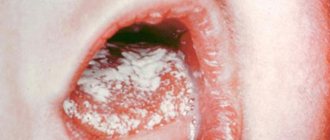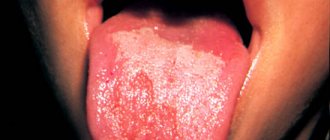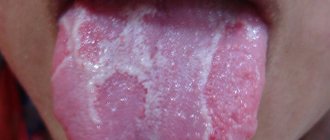Plaque on the tongue: normal or pathological
The tongue is a muscular organ in the oral cavity that performs a number of functions.
First of all, this is the determination of taste, speech, as well as mixing food in the mouth and pushing it into the esophagus. Even in ancient times, doctors noticed an interesting feature. It turns out that color, shape and other changes in the tongue often occur as a result of pathological changes in the body, in particular in the gastrointestinal tract. Therefore, during a physical examination, doctors often ask patients to stick out their tongue. The appearance of this organ is very informative for the doctor.
The normal color of the tongue mucosa is pale pink. Depending on various circumstances, a slight white coating is allowed. In the warm season (late spring, summer) the coating is thicker, and in cold time it is thinner. A slight yellowish tint of coating on the tongue is also considered a normal variant. In some cases, white and yellow plaque indicates diseases of the oral cavity, which are not difficult to cope with.
Please note that plaque on the tongue is not always caused by disease. If the tongue is coated, then the following circumstances could lead to this:
- Insufficient oral hygiene . In such cases, a person is bothered not only by plaque on the tongue, but also on the teeth, as well as bad breath. To eliminate the problem, you just need to properly monitor the condition of your mouth and teeth.
- Dehydration and dry mouth . The tongue becomes coated if the body does not have enough water. Dry mouth is one of the symptoms of dehydration. In such cases, little saliva is produced, which is why plaque appears. Dry mouth is often caused by not drinking enough fluids. Sometimes dehydration indicates diabetes mellitus, in which the body loses a lot of fluid due to forced diuresis.
- Bad habits . It is common for smokers and those who like to chew tobacco to have a coating on their tongue. As soon as you say goodbye to the bad habit, the problem will disappear. The same is true for persons who abuse alcoholic beverages.
- Breathing disorders . If a person has impaired nasal breathing (for example, due to a deviated nasal septum) or often breathes through the mouth, this contributes to the appearance of plaque on the tongue.
- Nutritional Features . When eating mainly soft foods, vegetable or fruit purees, the likelihood of plaque on the tongue increases.
- Taking certain medications . For example, with long-term use of antibacterial drugs, the microflora of the oral cavity is disrupted. This contributes to the appearance of a fungal infection, one of the symptoms of which is a coating on the tongue.
It is easy to notice that there is almost no plaque at the tip, while the largest layer is noted at the root of the tongue. This is due to the fact that the tip of the tongue is movable, and the base and basal region comes into contact only with the palate.
What pathologies cause plaque on the tongue?
Since the tongue is inextricably linked with the digestive organs, the appearance of plaque often indicates diseases of the gastrointestinal tract. However, there are other diseases in which the tongue becomes coated. Consider these diseases:
- Gastritis . The most common cause of abundant white coating on the tongue is gastritis. At the same time, the tongue is covered with different types of gastritis - autoimmune, hemorrhagic, chronic atrophic gastritis, as well as gastritis with low acidity.
- Bulbit . This is an inflammatory disease of the duodenum. Bulbitis is characterized by both acute and chronic course. In this case, inflammation in this pathology can be focal (local) or diffuse. Most often, with bulbitis, the tongue becomes covered with a white or yellowish coating.
- Gallbladder diseases . The tongue with biliary dyskinesia and cholelithiasis also becomes white or yellowish.
- Duodenitis . This is an inflammatory pathology of the duodenum. With duodenitis, erosions appear in the intestines, and the intestinal glands are also affected.
- Sore throat (acute tonsillitis) . This is an acute inflammation of the tonsils, accompanied by fever and often a white purulent coating on the tonsils and tongue.
- Thrush (candidiasis) . A fungal disease caused by bacteria from the genus Candida is known as thrush. Candidiasis affects not only the urogenital tract, but also the oral cavity. Thrush is characterized by an abundant white, cheesy coating on the tongue.
- Glossitis . This is an inflammation of the tongue, most often caused by pathogenic microorganisms or injury. The coating on the tongue with glossitis is white, yellowish or grayish, depending on the type of pathology. Ulcerative glossitis is also characterized by the appearance of bad breath.
- STD . Sexually transmitted diseases are also sometimes accompanied by heavy plaque, especially on the root of the tongue. Such manifestations are possible with syphilis or HIV infection, against the background of which there is a decrease in immune status.
- Diabetes . With an increase in the concentration of glucose in the blood, opportunistic and pathogenic microflora are activated. The risk of infections, including in the oral cavity, increases. In addition, diuresis increases with diabetes. The patient is bothered by a frequent urge to urinate, which causes the body to lose fluid. This leads to dry mouth and plaque on the tongue.
- Diarrhea and vomiting . These are symptoms of many diseases. With diarrhea and vomiting, dehydration also occurs, which contributes to the appearance of white plaque.
Plaque on the tongue also appears with a number of other infectious and inflammatory pathologies, chronic diseases and lack of vitamins. However, such a symptom is not specific to any disease. In other words, a patient cannot be diagnosed based on plaque on the tongue alone. A coated tongue only allows the doctor to assume the presence of a disease, but not to diagnose it based on this symptom alone.
How to recognize a disease in a child by language?
The language reflects the state of the child’s health as a whole and the functioning of each important organ separately. From it you can “read” even about the smallest changes in diet, drinking regimen, about a mild cold and poor sleep. That is why the doctor, every time examining a sick or healthy baby, asks him to open his mouth and stick out his tongue. Parents can also notice something, the main thing is to learn to understand the signals.
Anatomy in simple terms
The tongue has many tasks: it mixes food during chewing, determines the taste of food, without it correct speech is impossible. And the organ consists of muscles covered on top with a mucous membrane, and is divided into two parts, between which there is no clear boundary. The back - the root - on one side fuses with the mucous membrane of the mouth. The front - the body - moves freely in different directions. The upper surface of the tongue is called the dorsum.
The correct type of tongue in a child
Normally (in both children and adults), the tongue should be uniformly pink, slightly uneven due to the papillae that are velvety to the touch, moist and shiny from the saliva constantly produced in the oral cavity. There are 4 types of tongue papillae. The smallest, thread-like, cover the entire surface of the tongue and look like carpet pile. Those that are larger, mushroom-shaped, are located on the back between the filamentous ones. The leaf-shaped ones resemble the gills of fish and are located on the lateral surfaces. In adults they are less visible than in children. The largest papillae are groove-shaped, there are not very many of them, from 7 to 11, and they are located on the back of the back, actually defining the boundary between the body and the root.
Studying the “map” of a child’s language
If a child’s tongue changes color or structure, or a persistent coating appears on it, parents should be wary and think: what exactly is happening to the baby? They rush to the doctor for an answer. The doctor asks the baby to open his mouth and show his tongue. And everything immediately becomes clear to the specialist. And there is nothing surprising about this. Each organ has its own “place” in the language, or rather, a projection. The papillae of the tongue, taken together, are almost ten thousand taste, thermal and biochemical analyzers. Directly related to parts of the intestines, liver, gall bladder, spleen, central nervous system, etc. And by the presence of changes in a certain area, one can judge the condition of a particular organ.
Looking for differences
The tongue can change color and thickness; it happens that cracks, furrows, papillomas, blisters, ulcers, and plaque appear on it. Their location, color and structure indicate a diseased organ.
- Color. A pale tongue “hints” at anemia, which occurs as a result of the child’s body not having enough iron. Bright red indicates a deficiency of vitamins A, B, E and an infectious disease, such as scarlet fever, and also often accompanies fever, intoxication, sore throat and pinpoint rash on the skin. A bluish tint (if the baby has not eaten blueberries, blueberries, black currants or colored sweets) indicates chronic problems in the functioning of the cardiovascular or respiratory systems.
- Structure. The appearance of blisters on the tongue that quickly turn into ulcers is considered the first sign of herpetic or bacterial stomatitis, an acute allergic reaction to food or medications. To figure it out, you need to carefully analyze the circumstances preceding the changes and remember what the baby’s menu consisted of, whether he had contact with people with herpes, and whether he violated hygiene standards.
The “geographical” tongue is covered with deep grooves of different sizes and colors, giving the surface of the organ the appearance of a relief geographical map. The language of children prone to food allergies becomes like this especially often. The location of inflamed and non-inflamed areas of the mucous membrane (“continents” and “seas”) accurately indicates the involvement of a particular organ of the digestive system in the process. And besides, a “geographical” tongue may be evidence that the baby has worms.
If your child has a coating on his tongue
This happens most often with the tongue. If the child is healthy, then there should not be any coating on the tongue, except perhaps a thin whitish one at the base. It is allowed as a variant of the norm and disappears after cleansing the tongue. The first reason for a persistent white coating on the tongue is poor hygiene. Oral care involves more than just brushing your teeth: you shouldn’t forget about your tongue either, and wipe, clean and wash it more often using special devices. Finger toothbrushes with a ribbed surface are perfect for little ones. Plaque, indicating a disease, can be of any color - from the same white to black, of different thicknesses and cover both small areas of the tongue and the entire surface of the organ. To clarify the diagnosis, in addition to color, the location of the plaque must also be taken into account.
- White cheesy plaque , easily scraped off, but leaving behind a bright pink inflamed mucous membrane, most likely indicates candidiasis (thrush) of the oral cavity. This is an extremely common disease that affects infants and is caused by the active development of candida fungus on the mucous membrane of the mouth or intestines. Typically, such plaque appears in the central part of the tongue, as well as on the cheeks and gums.
- A thick white coating on the tongue accompanies infectious diseases, such as tonsillitis or scarlet fever. If they begin, the tongue is coated for the first three days, and then acquires a bright crimson color, the papillae of all groups increase in size. And with viral respiratory infections (flu, measles), the tongue changes only after three days from the onset of the illness, namely, it turns red, increases in volume (swells) and dilated blood vessels appear on it.
- A thick white coating on the tongue indicates problems in various organs, but primarily in the digestive system. If the entire tongue is swept, which has also become swollen and wet, there is a symptom of poisoning, appendicitis, cholecystitis, gastritis. Plaque along the edges on the front part - possible pathology of the respiratory system; on the back third of the tongue - problems with the large intestine; in the middle part - problems with the duodenum; in the middle of the tongue with a red tip - the likelihood of increased stomach acidity. With low acidity, the tongue is white and dry. Plaque at the same time on the root and along the edges of the tongue gives reason to think that the child may have kidney disease, and “advises” additional examination.
- Yellow plaque is most often formed due to disruption of the liver and/or gallbladder. When these organs are damaged, bile flows from the stomach into the oral cavity, which turns the tongue a corresponding yellowish color. If the outflow of bile is impaired (cholestasis), the color may change to greenish.
- A yellow-white coating covers the tongue during intoxication during poisoning or constipation.
- Gray plaque occurs as a result of long-term problems in the functioning of the gastrointestinal tract.
- Black or dark brown plaque occurs after prolonged use of antibiotics, leading to an imbalance of intestinal microflora. Sometimes it indicates a disease of the urinary system.
It is clear that based on the metamorphoses that have occurred with the tongue alone, the doctor will not make a final diagnosis. But they will give him a hint and help him find the reason.
The tongue is divided into three parts: the tip of the tongue is usually associated with the heart and pericardium, the middle third with the stomach and pancreas, the posterior third of the tongue and the root correspond to the small and large intestines. The left side of the tongue is “responsible” for the left lung, spleen and left kidney, the right side is responsible for the liver, right lung and kidney, as well as the bladder.
Doctor's advice
To correctly determine whether the state of the language has changed, you need to:
- make sure that the child does not consume foods, drinks or medications that stain the tongue;
- examine the tongue in natural light;
- carry out the check in the morning, before hygiene procedures and meals;
- ask the baby to stick out his tongue without tension, which will cause the organ to “turn red.”
It is a fact
Symptoms of diseases appear on the tongue about a day or two before the affected organs begin to hurt. Therefore, it would not be superfluous to regularly inspect your tongue just in case. If you notice any changes, it is best to contact your pediatrician. There can be a lot of reasons for metamorphosis, and only a competent specialist will make a correct diagnosis.
Plaque on a child's tongue
Plaque on the tongue of a child, like an adult, occurs due to the above circumstances or diseases. Often the cause of plaque in a child is insufficient oral hygiene. Since children often suffer from acute respiratory viral infections, the tongue often becomes clogged with sore throats and other inflammatory diseases of the oropharynx.
White coating on the tongue of infants is also considered normal, since babies do not yet produce enough saliva to wash off the milky coating. If plaque appears frequently on your baby’s tongue, then this is a reason to consult a pediatrician. It is important to exclude possible pathological changes that can lead to such a symptom.
The tongue turned black. What to do?
Many people wonder: what to do if your tongue turns black and which doctor to go to. Do not forget that a dark coating on the tongue is just a symptom of a serious illness. To eliminate it, it is necessary to cure the disease itself. First of all, seek help from your dentist. It will be necessary to conduct an analysis and a full examination of the oral cavity. If everything is fine with the teeth, the doctor will write out a referral to other specialists (general practitioner, gastroenterologist, etc.).
Oral hygiene rules during treatment
While the main cause of darkening of the tongue is being treated, patients should adhere to the basic rules of good hygiene:
- Brush your teeth and tongue 2 times a day
- Use a tongue scraper (removes plaque better)
- Use mouth rinses
White coating on the tongue: why it appears and how to remove it
The most common is a white coating on the tongue, which most people experience. This is a layer of dead epithelial tissue, as well as bacteria and organic compounds, which acquire a whitish hue when deposited on the surface of the tongue.
The cause of plaque is inflammation of the papillae of the tongue. When inflamed, they become larger, which causes the space between the papillae to increase. In this space, dead tissue, bacteria and organic substances “get stuck”, forming a characteristic white coating.
In most cases, a small amount of white coating on the tongue does not indicate health problems. Often this symptom is temporary and is associated with poor oral hygiene, smoking, drinking alcohol, eating disorders and other circumstances.
In some cases, a white coating coats the tongue in diseases such as gastritis, thrush, tonsillitis, lichen planus, syphilis and others. Since plaque on the tongue is also considered a physiological norm, it is recommended to consult a doctor under the following circumstances:
- If there is too much white plaque.
- With frequent episodes of plaque on the tongue for no apparent reason (smoking, poor oral hygiene, etc.).
- For pain in the tongue or mouth, which is often associated with inflammatory pathologies.
- If plaque on the tongue is accompanied by other symptoms (usually gastrointestinal diseases), such as nausea, vomiting, abdominal pain, dizziness, diarrhea and others.
- If you experience dry mouth and increased urination. These symptoms are typical for diabetes.
- In cases where plaque on the tongue persists for several weeks.
Getting rid of plaque on your tongue is not difficult. To do this, it is enough to maintain oral hygiene. Remove plaque using a special tongue cleaner. Also, on many toothbrushes, the back side is presented in the form of a tongue scraper.
If the plaque is caused by pathologies, then you can get rid of the problem only after treatment. In some cases, getting rid of plaque is not so easy. For example, with a sore throat or thrush, the plaque becomes covered with a dense film, which makes it quite difficult to remove it mechanically.
Important! Maintain good oral hygiene. Brush your teeth and tongue twice a day. This will help avoid a number of complications, in particular fungal and bacterial infections.
What should a healthy tongue look like?
Dentists explain that a healthy tongue is pink in color and evenly covered on top with small seals called taste buds. The appearance of the tongue changes with certain diseases, sometimes very dangerous. If your tongue has become a different color, is swollen and painful, or has permanent plaques or ulcers, contact your dentist or physician to find out what is causing this.
Changing tongue color
A change in the color of the tongue and the appearance of streaks or bumps on it may be a sign of a dental or systemic disease. According to the MSD Manual, a white coating or whitish patches on the tongue can occur due to oral thrush, leukoplakia associated with alcohol or tobacco use, fever, dehydration, and skin conditions such as lichen planus. Another reason for the appearance of a white coating on the tongue is the habit of breathing through the mouth.
The tongue becomes smooth, red and sometimes swollen due to anemia and vitamin B3 deficiency. The tongue acquires a characteristic strawberry color during scarlet fever and in young children with such a serious illness as Kawasaki disease. If you suspect scarlet fever and Kawasaki syndrome, you should immediately seek medical help. In case of anemia, the tongue may not become red, but, on the contrary, pale.
Experts note that the tongue can also take on a “hairy” appearance and turn brown, greenish or even black. In most cases, this does not pose a threat to health: such a change in the color of the tongue is often associated with the accumulation of dead skin cells on the taste buds. According to the MSD Manual, a black tongue can also be caused by taking medications that contain bismuth.
What else is there like a coating on the tongue?
In addition to white, in some cases the tongue is also covered with a coating of other colors. Let's take a closer look at what the color of plaque on the tongue means.
Yellow plaque
When a yellow coating appears on the tongue, the first thing you need to think about is the food that turns the tongue yellow. For example, these are citrus fruits, turmeric, curry and other foods and spices containing yellow pigments.
If you have not eaten yellow-colored foods, such plaque often occurs due to liver and gallbladder diseases. Be sure to consult your doctor, especially in cases where the plaque lasts for several days.
Sometimes a yellowish coating also occurs when dehydrated, but disappears within a day after quenching thirst.
White plaque with red spots
The presence of red spots on the tongue indicates an inflammatory process. This symptom indicates glossitis. With glossitis, the papillae of the tongue merge and form spots. Visually, such spots resemble continents with seas, which is why glossitis is also called geographic tongue.
With glossitis, in addition to plaque, the patient may also experience pain and discomfort when eating and drinking. Glossitis usually goes away within a few days. The only condition is to maintain oral hygiene. If the disease does not go away, then you should consult a dentist.
Orange plaque
An orange coating, like yellow, also forms after eating citrus fruits, turmeric and other fruits and spices of bright yellow or orange color. In addition, an orange coating on the tongue occurs with diseases of the liver, gall bladder, pathologies of the urinary system and disorders of the digestive system.
Brown plaque
As with yellow or orange plaque, the first thing to think about when brown plaque appears is the food you recently ate. The tongue acquires a brownish tint after drinking coffee, cocoa or chocolate, although under the influence of saliva in such cases the tongue quickly clears.
Long-term use of a number of medications (in particular, antibiotics) is another cause of a brownish coating on the tongue. As for diseases, brown plaque often occurs against the background of diseases of the gastrointestinal tract, excess mucus in the body, as well as stomatitis and kidney pathologies.
Black plaque
This is an extremely rare occurrence. Black plaque appears when the balance of microflora in the oral cavity is disturbed. Some types of opportunistic and pathogenic microbes, feeding on dead tissues of the oral cavity, deposit black waste products on the tongue.
The appearance of a black coating on the tongue is sometimes associated with pathologies of the liver, gall bladder or spleen. Contact your doctor immediately if this symptom occurs.
How to get rid of plaque on your tongue
Depending on the color of deposits on the tongue, the duration of the symptom and a number of other circumstances, to get rid of plaque we recommend following the following recommendations:
- Maintain oral hygiene by using toothbrushes and tongue cleaner. This is enough if we are talking about periodically occurring white plaque.
- See your doctor if yellow, red, brown, black, or heavy white plaque appears. It is important to get diagnosed and eliminate the root cause of the disease.
- Use antibiotics and antifungal medications only as directed by your doctor. Antibiotics are prescribed when the bacterial nature of the disease is established (for example, with a sore throat), and antifungals are prescribed for fungal pathologies (for example, with thrush).
- During treatment procedures, avoid consuming sweets and alcoholic beverages.
FAQ
How to get rid of plaque?
Maintain good oral hygiene. If the plaque does not go away within a few days, consult a doctor. The true cause of the plaque must be determined and appropriate treatment carried out.
What does white coating on the tongue mean? Is this normal or pathological?
In most cases, this is the norm. White plaque also occurs in a number of diseases. If plaque appears frequently while maintaining oral hygiene, then it is quite possible that the problem lies in a disruption of the gastrointestinal tract. The most common cause in this case is gastritis.
Do I need to clean my tongue?
Just like your teeth, your tongue needs regular care. Just don't clean your tongue with a brush. The stubble will damage the papillae of the tongue, causing inflammation. Use special tongue cleaners.
Prevention
- Balanced diet
- Taking vitamins and minerals
- Rejection of bad habits
- High-quality oral hygiene
- Timely treatment of dental diseases
By the way, to treat teeth under anesthesia without pain and fear. Minsk Family Dentistry Center "Medexpert" provides treatment during sleep using drug sedation. This approach allows you to fight fears and eliminate feelings of discomfort. Sedation increases the pain threshold, reduces salivation and at the same time maintains the performance of all vital functions of the body. While the patient sleeps peacefully, the teeth are put in order. Convenient, comfortable and safe!
Black plaque on the tongue usually occurs in adults. However, a child can also be susceptible to such an unpleasant phenomenon. If you discover this symptom in yourself or your baby, consult a doctor immediately!











